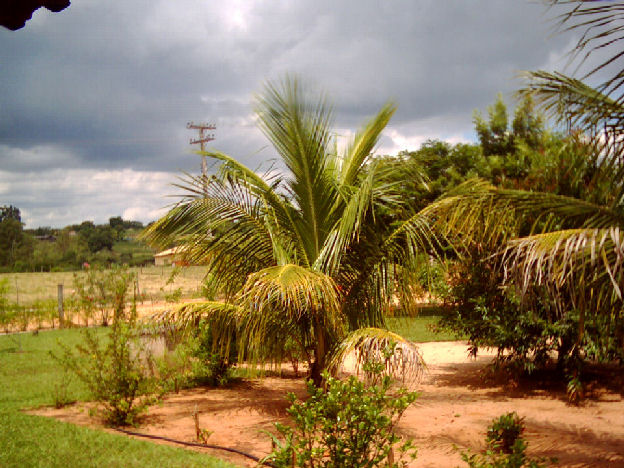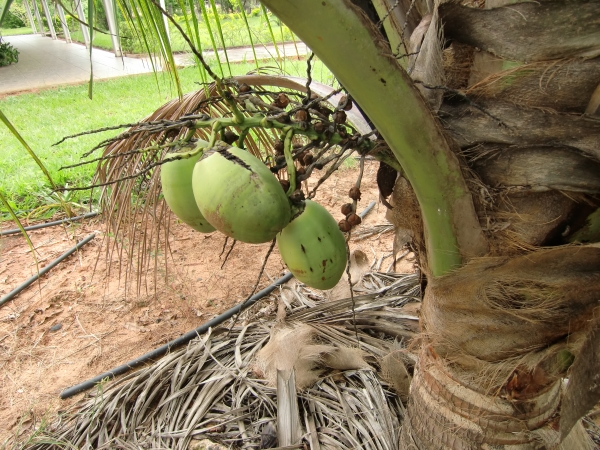

In our yard are 3 specimens. The coconut palm is one tropical crest tree from the family Arececeae, at this the coconut is growing. It grows mostly 20 to 25 meters (67 to 83 feet) tall, but not more than 30 meters (90 feet). It forms leaf crowns of 2 to 3 meters (10 to 23 feet) long feathered leaves. The tree also takes permament sea winds and often survives strong storms and hurricanes. Coconut palms don’t branch. Cocos nucifera ist he only species of the genus, however are crosses with Syagrus, Butia and Jubaea theoretically crossable. Cross trials with these species are also planned.
The coconut palm has high heat claims and does not take frosts, is not hardy in Europe. It is a tree of the humid tropics, it grows mainly on the coasts and islands, and up to 150 km inland along rivers. Further inland only grown. It does fruit only between 26 degrees south or north latitude. Coconut palms are not uncommon in the gardens in Lucianópolis. Lucianópolis has a frostfree climate, which is a planting of coconut palms without winter protection possible. Also a forming of fruits in Lucianópolis are noticable.
From the leaf axles the branched inflorescences grow from the sixth or seventh year, each with up to 40 female and over 10,000 male flowers. The female flowers open only two weeks after the male and about two days fertile, so that cross-pollination predominates. Pollination by both wind and by insects (bees, wasps, beetles, ants, flies) does occur.
The tree bears year-round fruit, which in its crown into groups of different stages of development grow, so that ripe coconuts grow steadily. Depending on the location they flourish and bear fruit with full power from 15 to 60 years, but also at optimal locations with at least 80 years of their fruit production. The maximum age of the coconut palm is 100 to 120 years.
The average yield is from 50 to 80 ripe fruit per tree and year. On optimal locations can also be 70 to 150 nuts per year harvested.
The coconut is harvested as a green, relatively immature, triangular, slightly more than head sized fruit. The actual seed is coated by a thick fibrous layer of a leathery outer layer (exocarp), one at first fiber-rich fleshy then air containing mesocarp and an almost rock hard 5-mm-thick inner shell. Before export, the outer layers removed, in order to save space transportation. The 20 to 30 cm long ripe fruit weighs 900 to 2500 grams
The cavity is containing about one liter of sweet, almost clear liquid, the coconut water. This is sterile, while the nut remains closed. In the producing countries is the coconut water from the less mature fruit an important drinking water replacement. The coconut water is less with increasing maturity, but it is completely consumed until germination.

One of our three coconut palms in our yard in January 2008

Fruits at one of the three Cocos nucifera in December 2009.
Updated by Joachim Jaeck on March 10th, 2010